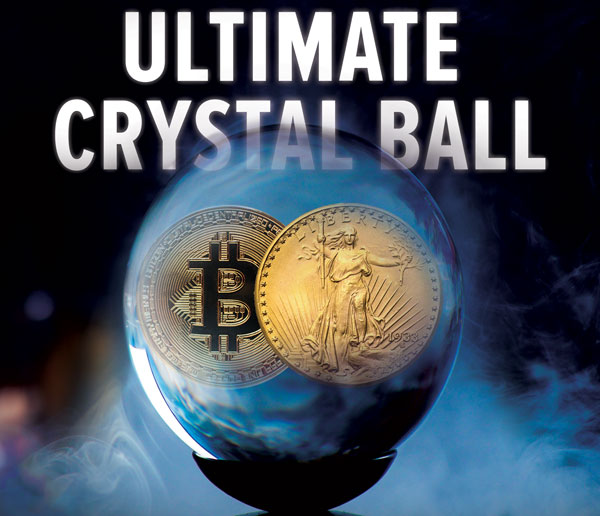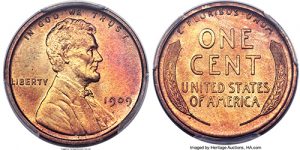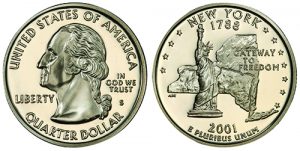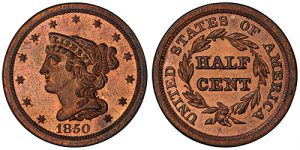
Bitcoin vs. gold. That’s the question everyone wants to be answered. What will coin collecting look like in 2041? Here’s an ultimate crystal ball prediction.
Crypto followers say that Bitcoin facilitates payment better. But gold is a currency that preserves purchasing power. So where will gold and cryptocurrency be in 2041?
Bitcoin is relatively new, and gold has served humanity for 5,000 years.
Thinking many years into the future can be all at once frightening and exhilarating. Attempting to look ahead 20 years from when this was published in June 2021 may seem like a fanciful notion. But if we put those two decades into historical perspective, we realize that 20 years is the same span of time that has elapsed since 2001, a period that for many of us may seem like only yesterday.
Sure, a lot has happened in the past two decades: the 9/11 attacks, the Great Recession, and the COVID-19 pandemic, just to name a few major milestones. But in hindsight, we can safely say we already saw shades of 2021 back in 2001. At the time, modern social media was in its infancy with the rise of instant messaging services and early interactive websites such as SixDegrees.com and blogging website OpenDiary.com.
Bitcoin vs. Gold – Yesteryear 2021
With the terrorist attacks on the World Trade Center in New York City and the Pentagon in Washington, D.C., we entered a new era of counterterrorism awareness that continues to this day in countless areas of daily life. In 2001, Americans were already replacing their bulky cathode-ray televisions and videocassette recorders (VCRs) with massive flat-panel TVs and digital video disc (DVD) players. Meanwhile, the Toyota Prius was already harkening a new era in the low-emission cars that have since become ubiquitous on American highways and byways.
And while much has changed in the numismatic world since 2001, it’s easy to see how we got from where we were in the hobby 20 years ago to where we are today. By 2001, the United States Mint was well into its 50 State Quarters program, which ushered in a new era for the hobby and has since been parlayed into the numerous other multi-design coin programs the U.S. Mint embarks on today.
Elsewhere in the coin universe, the Professional Coin Grading Service (PCGS) had brought its popular Set Registry® program to the internet in 2001, broadly changing what numismatists collect and how they show off their collections. And little did most people know it then, but gold prices, which had hit a decades-long low over the summer of 2001 with levels of around $267 per ounce, were beginning a protracted upward swing during the autumn of that year on their path to the four-figure prices we see today.
Bitcoin vs. Gold – Putting it in Perspective
When we put the past 20 years into perspective, we realize that the world we know today was taking shape in 2001, and it’s suddenly less daunting to prognosticate the future as it could be 20 years henceforth. Perhaps it’s just as reasonable to suggest that predictions as to what the future will look like in 2041 can be rationally informed by the trends, inventions, and dreams of today. It’s with this educated understanding of the past and present that we boldly look ahead toward the future of coin collecting and investing 20 years beyond the horizon.

Maurice Rosen is one of the hobby’s great numismatic prognosticators and publisher for decades of the hobby and industry’s original Annual Crystal Ball Survey. The Plainview, New York, coin expert has been a full-time coin dealer since 1968 and is the editor and publisher of the award-winning Rosen Numismatic Advisory, which debuted in January 1976.
Rosen’s newsletter has won over 30 awards from the Numismatic Literary Guild. As the president of Numismatic Counseling, Inc., Rosen has led seminars throughout the United States forecasting numismatic and precious metals market conditions and advising standing-room-only crowds on the most lucrative areas of the market now and in the future.
National Debt Over $100 Trillion by 2041
“Our nation’s finances are as bad as I’ve ever seen them, and it’s a safe bet that today’s $28 trillion national debt will be well over $100 trillion by the year 2041,” says Rosen peering ahead. “Actually, based on its growth rate for the past many years of 8% per year, the debt could very well be $130 trillion, and that’s without a major monetary crisis, war or national emergency.”
This, he believes, will lead to a period of high inflation. “It also concerns me, but I must say the trend is irreversible, that the government will be taking more control over the economy and our lives, with more intrusive rules and regulations, including the tracking of monetary transactions.
It is quite likely that private assets will be highly sought by the population. Technology is a wonderful thing, but in the hands of the government, it serves to increase their power and control.” He also thinks some vast changes will be underway that completely reimagine monetary policy as we know it today. “I’m anticipating that there will be at least one global monetary reset by 2041 and that the current U.S. dollar will be replaced with a new dollar, likely a digital dollar.”
At a Generational Pivot Point
Rosen builds that general economic outlook to serve as the backdrop for his predictions about where numismatics and bullion investing may go over the next 20 years. “As for the coin market itself, it appears that we are at a generational pivot point. The majority of current market participants are in the 60-plus age bracket; in 2041, those left will be 80-plus years old,” he notes.
“Clearly, unless replaced by enough younger participants and by significant economic forces that will make buying coins an attractive pursuit, the influence of those older folks will be gone as their heirs liquidate their coins.” He says he has yet to find the answer to reverse those trends. “I know the industry has made many attempts to introduce the younger generation to the hobby, but the factors that gave rise for the hobby’s growth during the 1950s through the 1970s have been eluding us.”
Risk of Inflation
Even still, Rosen points out the growing risk of inflation makes assets such as rare coins an “attractive investment refuge,” especially when coupled with the likelihood of higher prices for precious metals, a phenomenon that usually drives investors and the general public to the avenue of rare coins. “There’s one thing I’ve noticed over my career that can be counted on, and that is the promotional and marketing efforts of the industry to seize on opportunities that produce higher revenue.”
He adds, “Gold is the ultimate money; it has served mankind well for some 5,000 years. Gold will fulfill its role to preserve wealth and purchasing power over a long time. I’m on record predicting $5,000 to $10,000 gold and $150-plus silver by the end of the 2020s. That may prove to be too-conservative targets to be achieved by the end of the 2020s and exceedingly too conservative with the benefit of the additional years to 2041.”

But why does he believe gold and silver will shoot for the stars over the next 20 years? Surely the dire economic outlook of increasing inflation and possible upheaval in long-established monetary systems owe to some of this.
However, Rosen poses another reason bullion prices could see many bullish years ahead. “I anticipate the government will not be making it quite as easy as it is today for people to make transactions of precious metals. While I’m willing to rule out the threat of confiscation, I believe it is difficult to see how excess profit taxes on precious metal gains can be avoided.”
Trophy Coins
As for rare coins, the numismatic scholar is confident that top-end rarities, the type that makes news headlines when they cross the auction block, will continue leading the way. “Our highly-prized trophy coins – a term I ‘coined’ a few decades ago – will do marvelously well. They satisfy the criteria favored by affluent buyers. Such coins are private and compact assets, highly mobile, pedigreed and documented by PCGS or Numismatic Guaranty Corporation (NGC), often enhanced further when accompanied by a sticker from Certified Acceptance Corporation (CAC). They are the true masterworks of numismatics.”
Of course, not everyone can afford to pay out six- and seven-figure sums for trophy coins. Rosen says there are numerous opportunities for those on a smaller budget to capitalize on the market growth that’s sure to touch many areas of the hobby over the next two decades. “On a much more affordable plan, true Gem Mint State and proof examples of popular large-size type coins should do well.”
 Sleeper Coins
Sleeper Coins
And what about sleepers? “Well, I’ve been fascinated with the half-cent coinage since becoming a full-time dealer more than 50 years ago. Did you know that the entire mintage for the denomination, from 1793 to 1857, is a mere eight million pieces?” He notes a relatively easy set of half cents is the Braided Hair type minted from 1849 through 1857. “The total mintage for the type is 544,000, of which perhaps only from 3% to 5% survive today. 1850 was always a favorite of mine (mintage 39,812); until recent years, it was available at moderate premiums to the common dates in the series. Its price has since exploded. Are there any other sleepers in the denomination?”
Whether buying expensive rarities or more common, lower-priced coins, Rosen’s key advice is to buy “solid-for-the-grade” coins. “Why? Over the next 20 years, we have to allow for technical innovations that will be developed to aid in the grading and valuation of coins. There could be a whole new grading system,” he poses. “Those coins that are at the low end of their grade, certainly coins that are ‘questionably graded,’ might be penalized.”
Ultimately, he wants all involved in numismatics to follow their passion. “Continue to enjoy the great hobby of coin collecting. There will always be collectors for these beautiful and historic artifacts.” He goes on to say, “The coin market, strong or weak, bullish or bearish, will always survive. Buy what you like. Read and immerse yourself in the wisdom and guidance of the many written works from the hobby’s greatest writers.”
John Albanese’s Measured View
Often nicknamed “Mr. Coin Industry” is John Albanese, the founder of NGC and one of the founders of PCGS. He’s also the founder and current president of CAC, a company that evaluates third-party graded coins from PCGS and NGC and awards oval-shaped green and gold stickers to those that he and his team believe represent the highest quality for their respective grades; green stickers go to premium-quality specimens, while gold is reserved for those pieces that could grade at least a full point higher. He’s been a full-time coin dealer for more than 40 years and has seen his share of market highs and lows.
His long-range view of the past and his observations on what has and hasn’t changed in all those years leads him to take a rather measured view of the changes that may occur in the collecting and investing scene over the course of the next 20 years. “I started going to coin shows 48 years ago when I was 14 years old,” he says. “I don’t think they are a lot different now than they were then except maybe they’re faster-paced today.”
 “I’d hope that by 2041, the Lincoln cent and Washington quarter are obsolete series. But the 1932-D and 1932-S Washington quarters were popular key coins 20 – why, 40 – years ago, and they remain so today. There’s little reason to believe they won’t be valuable coins in 20 years. But who knows? Maybe in 20 years, we’ll have a [Joe] Biden quarter!” he laughs. “However, there will always be key coins like the 1909-S VDB Lincoln cent and 1955 doubled die Lincoln cent. These are coins that people wanted years ago, and they’re still going to want them 20 years from now.”
“I’d hope that by 2041, the Lincoln cent and Washington quarter are obsolete series. But the 1932-D and 1932-S Washington quarters were popular key coins 20 – why, 40 – years ago, and they remain so today. There’s little reason to believe they won’t be valuable coins in 20 years. But who knows? Maybe in 20 years, we’ll have a [Joe] Biden quarter!” he laughs. “However, there will always be key coins like the 1909-S VDB Lincoln cent and 1955 doubled die Lincoln cent. These are coins that people wanted years ago, and they’re still going to want them 20 years from now.”
He continues, “Ultimately, desirable coins will always be desirable coins. Consider the 1895 proof Morgan dollar. It was the ‘king’ of Morgan dollars when I got into the hobby decades ago and remains so today. What will supplant that? They aren’t making 1895 Morgan dollars anymore.”
More Similar Than Different

Albanese remarks that one of the interesting things about numismatics is how principally unchanged the hobby remains today as compared to 20, 40, or even 100 years ago. “Unlike in medicine, where things are always changing, there has not been a whole lot of fundamental change in our hobby over the years, and it’s hard to see why they will change a whole lot in 20 years.”
But that doesn’t mean there won’t be some changes. “The American Silver Eagle series with the John Mercanti reverse is becoming an obsolete subtype in 2021. Maybe in 20 years it will be harder to find the 1986 silver Eagle, a coin that is already a little scarcer than others [in the series] today. It could become a highly collectible date. I also expect gold and silver prices to go up in 20 years, but then again, gas might also cost $10 a gallon in 2041.”
Before becoming the president of PCGS, Brett Charville was a coin dealer with more than 15 years of experience in handling vintage United States coins. Having personally witnessed nearly two decades of growth on the front lines of the numismatic scene, he feels confident in looking ahead at what the next 20 years could bring. “It’s becoming pretty clear that we’re at the front end of a larger macroeconomic trend that’s positive for rare coins and collectibles as a whole. I am genuinely of the belief that the coin market will be much bigger, broader, and stronger in 2041.”
COVID Doesn’t Dim the Spotlight

He says the COVID-19 pandemic has put a focus on collectibles and hard assets. “I don’t foresee that spotlight dimming even when we return to normalcy. PCGS’s goal in the future will, of course, be to remain the premier authenticator and certifier of rare coins in the world but also to serve as a beacon of strength and integrity and as a resource that collectors of all kinds can use our platforms and online resources to become more knowledgeable and make better decisions when collecting.”
Charville believes PCGS and other third-party coin-grading companies will continue developing and employing more technology to aid graders in their jobs while also improving the security of coins and, in a larger sense, the welfare of the marketplace. “In 2041, I’d imagine that third-party grading will have made tech advances sufficient enough that while humans still grade coins, there’s a significant ‘digital-assist’ component that allows the graders to be both more accurate and coins to be graded more quickly. PCGS and its parent company [Collectors Universe] will be a much more global brand, and it will be much easier for collectors in virtually any country to have their coins certified directly at PCGS.”
Near-Field Communication (NFC) Technology
Taking a look at what his company has achieved in the 35 years since its founding in 1986, Charville acknowledges that one of the biggest advancements PCGS has made in its history was taking its set registry online in 2001. Now, 20 years later, the PCGS Set Registry serves as a major platform for collectors who want to share their coin collections with others while competing for awards and bragging rights. This naturally leads one to wonder if there is anything PCGS has recently launched that may prove to be equally revolutionary over the next two decades.
Without skipping a beat, Charville offers his answer. “Near-Field Communication (NFC) technology has been one of the most important overall advancements we have made at PCGS in many years,” remarks Charville, who oversaw the implementation of NFC chips in select PCGS holders in 2019 and a full rollout in all holders in 2020.
“Not only are these revolutionary NFC chips now being included with every coin and banknote we encapsulate, but they are also providing a new level of anti-counterfeiting security that isn’t being offered anywhere else in our industry.” He says, “Just as the PCGS Set Registry set a new course for our hobby 20 years ago, I’m confident we will be looking back two decades from now and recounting just how significant the introduction of NFC technology in our holders was for numismatics.”
Bitcoin Not Gold
According to former hedge-fund manager and COINage Cryptocurrency Editor James Passin, another kind of technology will be driving the numismatic world in 2041: collectible non-fungible tokens, or NFTs. “The exponential rise of NFTs is one of the most significant and revolutionary use cases for cryptocurrencies,” says Passin.
“It creates a permissionless and censorship-resistant user-friendly platform for the construction and distribution of ‘digital real estate,’ which will ‘upload’ all financial value onto the blockchain while hastening the merger of the digital and physical realms and ultimately unlocking hundreds of trillions of dollars of new economic potential. NFTs will bifurcate into two parallel universes: collectible NFTs that have the potential to appreciate due to collector demand or speculation and functional NFTs that purely serve an administrative role.”

What does this mean? “In the coming years, it is highly likely that coin-grading agencies will add NFTs as tools to confirm the authenticity of the grading information presented on holographic stickers. The coming explosion of easy-to-use APIs that will plug into NFT networks will onboard billions of new users into esoteric markets, such as collectibles, improving liquidity and possibly reinflating premiums for collectibles, including coins.”
As Passin sees it, world economies are poised for turmoil in the years ahead as monetary systems based on paper currency struggle and possibly collapse. “Repeated violent boom-bust cycles will not derail the NFT revolution over the next two decades,” asserts the daredevil investor. “In my view, it is Bitcoin, not gold, that will rise from the ashes of the destruction of the world fiat monetary system. The question is if there will be a physical, metallic component to the cryptocurrency-digital monetary realm in 2041.”
This story about what is a bitcoin vs. gold previously appeared in COINage magazine. Click here to subscribe. Story by Josh McMorrow-Hernandez.














good